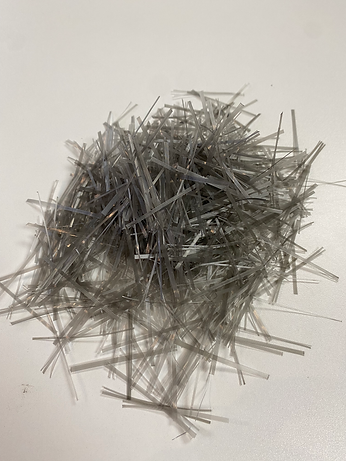




Microfibres VS Macrofibres
Choosing between microfibre and macrofibre for concrete depends on your specific project requirements. Microfibre and macrofibre are both types of synthetic fibres used in concrete applications and performs in different ways.
Below is a comparison of microfibre and macrofibre made from polypropylene, focusing on their properties, performance, applications, and other relevant factors in concrete.
1. Physical Characteristics
Microfibre (Polypropylene):
-
Size: Typically less than 1 denier (very fine).
-
Diameter: Usually around 0.5 to 1 micron, leading to a very fine fibre structure.
-
Surface Area: High surface area relative to volume, which allows for better bonding with the concrete matrix.
Macrofibre (Polypropylene):
-
Size: Typically ranges from 3 to 10 denier or larger.
-
Diameter: Can vary from approximately 20 to 100 microns.
-
Surface Area: Larger diameter and surface area compared to microfibers, designed to provide structural reinforcement.
2. Reinforcement Mechanism
Microfibre:
-
Type of Reinforcement: Primarily provides micro-level reinforcement that helps control early-age cracking and shrinkage.
-
Crack Mitigation: Reduces shrinking cracking and micro-cracking during curing process.
-
Durability Enhancement: Improves overall durability of the concrete by improving freeze-thaw cycles.
Macrofibre:
-
Type of Reinforcement: Offers macro-level reinforcement designed to handle larger, structural cracks.
-
Crack Control: Reduces the risk of larger cracks that can develop under stress or load and environmental factors, maintaining the integrity of the concrete over time.
-
Toughness and Ductility: Increases the overall toughness, ductility and impact resistance of the concrete.
3. Performance in Concrete
Microfibre:
-
Impact on Strength: While it doesn’t significantly increase tensile strength, it helps maintain the strength of the concrete matrix by controlling micro-cracking.
-
Surface Finish: Improves surface texture and finish, making it suitable for aesthetic applications.
-
Mixing Considerations: Requires careful handling during mixing to ensure even dispersion and avoid clumping, which can affect performance.
-
Potential Overuse: Relying solely on microfiber for crack control may lead to insufficient macro-level reinforcement, particularly in high-stress applications.
Macrofibre:
-
Impact on Strength: Contributes to both tensile strength and overall structural performance, especially in high-stress applications.
-
Crack Resistance: Effectively manages larger cracks and reduces the risk of catastrophic failure.
-
Mixing Considerations: Generally easier to incorporate into the concrete mix, offering good dispersion without the need for specialized mixing techniques.
4. Applications
Microfibre:
-
Ideal Uses: High-performance concrete applications, thin overlays, architectural finishes, decorative concrete, and repair work where surface quality is critical.
-
Common Industries: Often utilized in residential, commercial, and decorative projects, particularly where aesthetics are important.
Macrofibre:
-
Ideal Uses: Structural applications, including slabs, pavements, shotcrete, precast concrete elements, and areas subject to heavy loads or impacts.
-
Common Industries: Commonly used in infrastructure projects, industrial floors, and environments where significant mechanical stress is anticipated.
5. Cost Considerations
-
Microfibre: Generally more expensive than traditional reinforcement methods, which can impact budget considerations for larger projects.
-
Macrofibre: While still more costly than some traditional reinforcements, macrofibres often provide a good cost-to-performance ratio, particularly for structural applications.
6. Environmental Resistance
Microfibre:
-
Freeze-Thaw Resistance: Improves the freeze-thaw durability of concrete by reducing permeability.
-
Chemical Resistance: Offers good resistance to various chemicals, though the specifics can vary based on the formulation.
Macrofibre:
-
Durability in Harsh Conditions: Designed to maintain structural integrity under load and in variable environmental conditions, making it suitable for harsh environments.
-
Impact and Fatigue Resistance: Effective in maintaining performance under repetitive loading and impact conditions.
7. Conclusion
Microfibre vs. Macrofibre:
-
Microfibre is best suited for applications focusing on surface quality and micro-crack control, ideal for aesthetic finishes and high-performance settings.
-
Macrofibre provides essential structural support, making it preferable for high-load applications and addresses structural integrity and crack control on a larger scale.
Choosing between microfiber and macrofibre polypropylene depends on your project’s specific requirements. Your choice should be guided by the specific demands of your project, including load requirements, environmental conditions, and desired finish.
In many scenarios, using a combination of both can yield optimal performance in concrete applications.